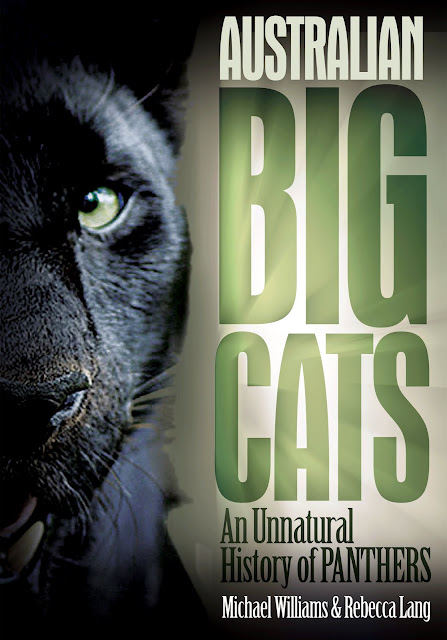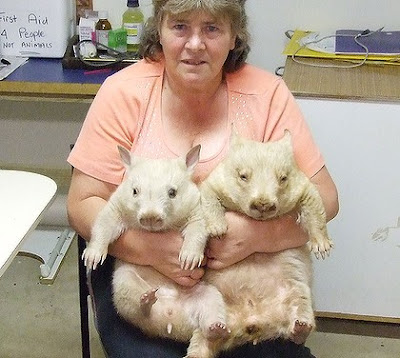More on those Tasmanian Tiger sightings in northern NSW...
There have been several recent sightings of an unusual 'dog-like' animal, seen in and around the region of northern NSW and north coast wildlife expert Gary Opit has been taking note, according to the Daily Examiner.
For the past 15 years, Mr Opit has been a regular guest speaker on ABC North Coast (formerly 2NR) and in that time he has received around 50 reports from callers describing an unfamiliar animal that he said resembles one of two species, possibly the marsupial lion (Thylacoleo carnifex), or the Tasmanian Tiger (Thylacinus cynocephalus).
While the last known Tasmanian Tiger died in Hobart Zoo in 1936, Mr Opit said that the most recent fossil evidence of the marsupial lion, which lived on Australia's mainland, was dated at around 3000 years old.
Many of the recent sightings have occurred around Mullumbimby, Nimbin and Byron Bay.
But before you jump to any conclusions, Mr Opit has been gathering newspaper clippings and eyewitness reports from all over Australia since the early 1960s when, as a young man, he first became interested in unusual and unclassified native animals.
"I always wanted to be a zoologist, was always visiting Taronga zoo and the Australian Museum and, as a 19-year-old Sydney teenager, I bought my first zoological text book, 'Furred Animals of Australia' by the Curator of Mammals at the Australian Museum, Ellis Troughton, our top zoologist," Mr Opit said.
"I was surprised to find between the studies and descriptions of the Tasmanian Devil and the Tasmanian Tiger, two pages dedicated to the Striped Marsupial-cat of North Queensland. Years earlier, in 1963, I had kept a clipping from one of the Sydney papers with a photograph of an unknown animal, described as the Ozenkadnook Tiger and taken by a Melbourne lady named Rilla Martin," he said.
Not long after, the young Gary Opit moved with his family to Surfers Paradise and it was here that he read and kept a letter to the editor to the Gold Coast Bulletin, published 22 September 1967, from Mr Carl Lentz, an early pioneer, who wrote in response to articles on a mystery animal observed by people on the edge of Southport living beside the State Forest.
He wrote: "Then a great strange head appeared out of the thick foliage. It was about to jump towards me so I quickly fired and it fell with a hard bump onto stones only two yards away. It was as big as an Alsatian dog. We tied its legs together with tough vines and stuck a long pole through them, by which we carried it home about half a mile. It was heavy. I intended to take it to Nerang 10 miles away by pack horse the next day and send it by train to the Brisbane Museum but owing to heavy rains all night causing the creek to flood we couldn't make the journey to Nerang so we measured it and skinned it instead."
"From the tip of the nose to the end of its long thick black tail it measured six feet, height of shoulder 25 inches, around the chest 23 inches. It was long in the body and strongly built on the forequarters, but more slightly built around the waist and hindquarters. It had two extra long sharp fang teeth, one and five eighth inches long besides the four ordinary incisor teeth. Its forehead and face was a light bronze colour. It had five bright orange rings of very short hair around its eyes. Its eyes were puce (purplish-brown) coloured. It had round ears of a pale fleshy colour, almost human ears. It had a short thick coat of light pale blue-grey and white stripes running downwards with bright, marble-sized orange to yellow spots along the flanks."
"From the back of the head covering the body it had a dark thin coat of black hairs and this made it appear a brindled colour at a distance when seen standing up from the side. The light pale blue-grey and white stripes running downwards along the flanks shone through the long thin outer coat of black hairs and looked very pretty close up. Its tail was covered with long black hair, underneath that, white and blue-grey rings an inch wide. It was a magnificent, male, specimen."
After this, Mr Opit heard reports of a similar experience, which happened to Gilston's first pioneer, Mr. William Duncan who related that the blacks called the animal a 'Punchum'
A couple of years later in 1969, Mr Opit was fortunate to himself see this animal cross the road at night and drew a picture.
"I used to work with Australia's most famous zoologist David Fleay at his zoo at West Burleigh, he was famous for filming the only movie footage of the last Tasmanian tiger in Hobart in 1936 and the first to breed the platypus. A couple of times people described to him the same animal that I had seen and he wondered if it could be a mainland representative of the Tasmanian tiger."
In the early 1970s, Mr Opit began working as a park ranger for the QLD National Parks, and while at O'Reilly's in Lamington National Park, he recorded wildlife but never heard any more about the Punchum and he thought that whatever it was it was probably extinct.
Then, in the mid 1980s and early 1990s, Mr Opit received reports and drawings from people on Tamborine Mountain where he lived on and off for 25 years, but he had never seen it himself even though he explored most of the forests identifying plants and animals.
"It was only after moving to live on Jones Road between Wooyung and Yelgun that I finally observed again what is probably the same unknown carnivorous marsupial, the Punchum, though this individual is very dark brown," he said.
"I have found it two other times in the Billinudgel Nature Reserve and both times it moved off rapidly."
"I have never really gone too public about it before, except mentioning it on my Wildlife Wednesday broadcast two or three times over the last 15 years of broadcasting, when listeners described a similar animal that they had observed. Eventually I put all the reports that sounded most like a thylacine together for the ABC website. I still don't know what it is."
As an Environmental Scientist, Mr Opit has assisted Australian Government's in all areas of conservation and is highly regarded in the Australian Crypto world as an authority.
To view Mr Opit's log of eye-witness reports, visit www.abc.net.au/local/stories/2008/02/262172927
* Reports of unusual animals have been circulating in Australia since the early days of white settlement and while many of these animals have since been identified and classified, a small number remain unexplained.
Wildlife expert Gary Opit said many of the reports he has recorded over the years describe an animal of similar characteristics and have come from ordinary, reasonable people, leading him to believe that witnesses have described the same species and weren't experiencing hallucinations.
"While some people report seeing distinctive bands or stripes on the body and tail, and others don't, I believe what they are reporting is almost certainly the same animal species, mostly likely a thylacine or thylacoleo," Mr Opit said.
Now Mr Opit is hoping the widespread use of smartphones will eventually lead to some firm evidence; preferably a video.
"It's just a matter of time," he said, adding that the scientific community would probably continue to ignore these anecdotal reports until there is some form of hard evidence, either a live animal or a dead one.
So far, Gary says, he hasn't received any reports of the mystery animal from the Clarence Valley region but he expects they inhabit bushland areas throughout eastern NSW.
Have you seen an animal you can't identify?
We'd love to hear about it.















